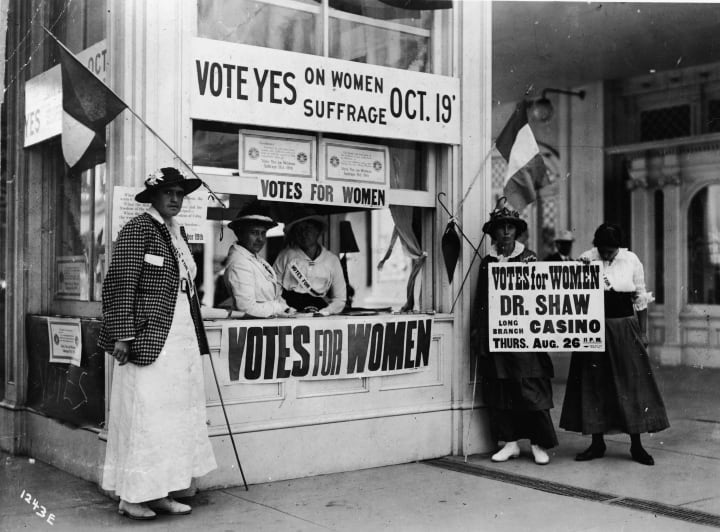What Is the Feminist Movement?
In a time of deep internal questioning and self discovery, many of us are wondering what is the feminist movement?

Traversing as far back as the 19th century, though not gaining true prominence until the 1970s, the feminist movement in its entirety spans across a great deal of history, and shares its roots within many other ranging political and social outcries, specifically Civil Rights. Debates wrought by the movement also have a variety of considerations, never specifically falling on one holistic issue, but more or less arguing them all first and foremost under one pretext: the importance of the woman.
Like most movements, feminism can be organized within three separate junctures of crucial importance, most often considered waves. In them, varieties of issues coagulate and reform, designing new approaches, opening up new portals of rhetoric, and igniting sparks of virtue wherein once it was too dark to see.
The feminist movement aged, like we all do, into what it now speaks so loudly of today, which is an open-ended equality among gender, race, age, sexual orientation, and so on. While the feminists may have subdued their movement over the premise of women, in a sense it grew up to accept many other forms of endearment.
To truly grasp and understand what is the feminist movement, one must travel far back in time, whereupon the first wave of feminism collides, and the propensity of the female first found its bubbling growth.
What Is the Feminist Movement: First Wave

Christine de Pizan's Epitre au Dieu d'Amour (Epistle to the God of Love) is, according to Simone de Beauvoir, the "first time we see a woman take up her pen in defense of her sex." Written in the 15th century, Pizan's literature wouldn't necessarily spark the feminist movement, but indirectly shaped the way women and literature came together in the hopes of making the female visage an icon, rather than a subset of man.
The first wave of the feminist movement mostly deals with the 19th and 20th centuries, wherein the suffrage movement extended from the United Kingdom to the United States, bringing with it a myriad of political and social debates. The foremost issues concerning feminists during this time was property rights and marriage. Toward the birth of the 20th century, however, these concerns soon blossomed into the hunt for other rights, such as economic, sexual, reproductive, voting, and more.
This wave is more commonly pooled into the terminology of the Suffrage Movement, which first unfolded into existence from the Seneca Falls Convention of 1848, organized by Lucretia Moss and Elizabeth Cady Stanton. There, outlined and immortalized by these and many other women, the Declaration of Sentiments was born, declaring equality among both genders and women's rights to vote. Not soon after, a train of gender equality commenced and would not stop. Names boarded at different points in time, such as Susan B. Anthony and Sojourner Truth, but they had yet to really identify it by name.
British suffragettes, or the more general suffragists, first initialized voting rights as a main contender for their revolt in 1903, when Emmeline Pankhurst and her two daughters founded the Women's Social and Political Union. It's not for another seven years, in 1910, when the word 'feminism' finally made its way from France to the US in describing the support of women's empowerment. The Representation of the People Act in 1918 helped to shift the revolt from voting rights to property ownership, for only women over 30 who owned a house could then vote under the new law, but ten years later it was extended to all women over the age of 21, which had essentially killed the Suffrage Movement.
What Is the Feminist Movement: Second Wave

While the American first wave feminism may have died away with women's rights to vote, or the passing of the 19th Amendment to the US Constitution, more pressing identifications were soon adopted in its wake. The downward spiral of ideals were mostly premised on temperance and anti-slavery, which both inherently birthed the forthcoming second wave of the feminist movement. These considerations greatly molded the feminist theory, ultimately bringing about a new and more outward mode of thinking for women everywhere, adopting not only its previous political insight, but cultural and social ideologies.
Whereas the first wave mainly focused on rights, the second wave divulged in other issues of equality, like discrimination, education, domesticity, employment, and sexuality. Following WWII, more and more women wanted to pursue higher educations and office jobs. The industrial mindset, alongside the brute violence of the previous two wars, helped mold the mid-1950s into a podium for the feminist movement to vent its deep-set social concerns. Simone de Beauvoir, French philosopher and writer, published her The Second Sex in 1953, identifying some of the major concerns held by women and the aspects of oppression largely felt by them all over the world.
One such voice was Betty Friedan and her Feminine Mystique, published in 1963, which challenged the male dominated society and women's role in the homestead, mainly arguing against certain social aspects of child care and homemaking. Gloria Steinman, creator of the magazine Ms. was another such voice with her own journalistic career, uncovering deeply controversial topics for young women of the time, like beauty, birth control, and sexual harassment. Herein is where they became known as the Women's Liberation Movement, first used in 1964, a retaliatory force that was not to be reckoned with — or, so they hoped.
Into the 1970s, radical feminist ideals were soon spread through the likes of anti-war sentiments, anti-porn, Civil Rights, and divisions of class. Gloria Watkins, most commonly known as bell hooks, offers great insight into the impact of feminism on the Civil Rights Movement in her FeministTheory, published in 1984. As more and more turned away from these issues with Vietnam, African American plight, and economic inferiority gaining more prominence, the Women's Liberation Movement slowly crescendoed, until the third wave grew out of this leftover radical momentum.
What Is the Feminist Movement: Third Wave

When, in the mid-1980s, certain attributes of the previous wave fractured and fell, out arose this new form of femininity. What many call or consider postfeminism, the third wave of the feminist movement examines the previous waves' misconceptions. Generated by mostly new-wave mentalities, like the punk rock Riot grrrls working to counter the male dominated 90s music scene, third wave feminism brought about new forms of interpretations as to the ideal woman. These interpretations were largely post-structuralist, working to open up debate as to the idea of feminism. Third wave feminists don't like calling themselves feminists, because it misinterprets the female identity and entirely hampers gender roles, which goes against their ultimate purpose.
Rebecca Walker's I Am the Third Wave, published in 1992,basically administered the term and ignited deeper thought into the movement itself. That same year, which was coined the "Year of the Woman," four women joined the only other two in the US Senate, which was a stunning feat that only magnified in the years that followed, bringing women to such titles as Attorney General and Secretary of State. Hillary Clinton can be considered an important icon for the role of feminism in politics, but more prominent issues surrounding their agenda were sex discrimination, gender violence, reproductive rights, domestic abuse, and rape.
Unfortunately, third wave feminism as an individual movement never seemed to lift off the ground as well as the previous two. With so few adamantly following it without restraint, there was no grounding to keep it stabilized. Held together by international values and the object of gender defiance, third wave feminism still exists to this day, but some are pointing forward, into the future, that is...
What Is the Feminist Movement: Fourth Wave

While the debate still necessarily stands as to the premise, nature, and even existence of the fourth wave feminist, many claim the movement is out there brooding in the unknown. Many women now ascertain that the involvement of technology has redefined and revitalized the feminine mindset, bringing prowess back to the considerations of gender roles. Kira Cochrane claims the UK saw a spike of fourth wave feminism around 2013, which focused on sexual inequality. Others say it started in 2008 on social media platforms to bring reproductive justice to the world, and other such justices associated with gender.
The British feminist writer Laura Bates began The Everyday Sexism Project in 2012, a social media campaign reporting on contributors of sexism all around the world. From here, more and more online forums and websites dedicated to helping feminist theory emerge throughout the following years. Rhiannon Lucy Cosslett and Holly Baxter both consider themselves fourth wave and their book, The Vagenda, tries to identify the contemporary woman through popular forms of feminist expression. Much of the fourth wave mentality seems to target internal identifications, while also harkening back on social and political incentives.
It's still being questioned today, but the nature of fourth way feminism seems to bring about a natural self-perceptive insight into the feminist movement as a whole by using technology. Some women who consider themselves fourth wave don't even identify it as waves, but instead view it as one large feminist movement. These are the women asking, "Is feminism a double-edged sword?" In this capacity, more ways of understanding and clarification will soon coalesce, and the ideologies held within fourth wave feminism may or may not ever emerge, but their root considerations will always be remembered by way of history, and subsequently technology. Carried on in the form of the feminist movement itself, gender's conceptual independence will continue to design itself far into the future.
About the Creator
Donald Gray
Politics may be a disgusting battlefield, but it is a necessary vice in our country, and a particular fancy of mine, like productivity and success. These are important facets in the modern world, and must be expounded upon.






Comments
There are no comments for this story
Be the first to respond and start the conversation.